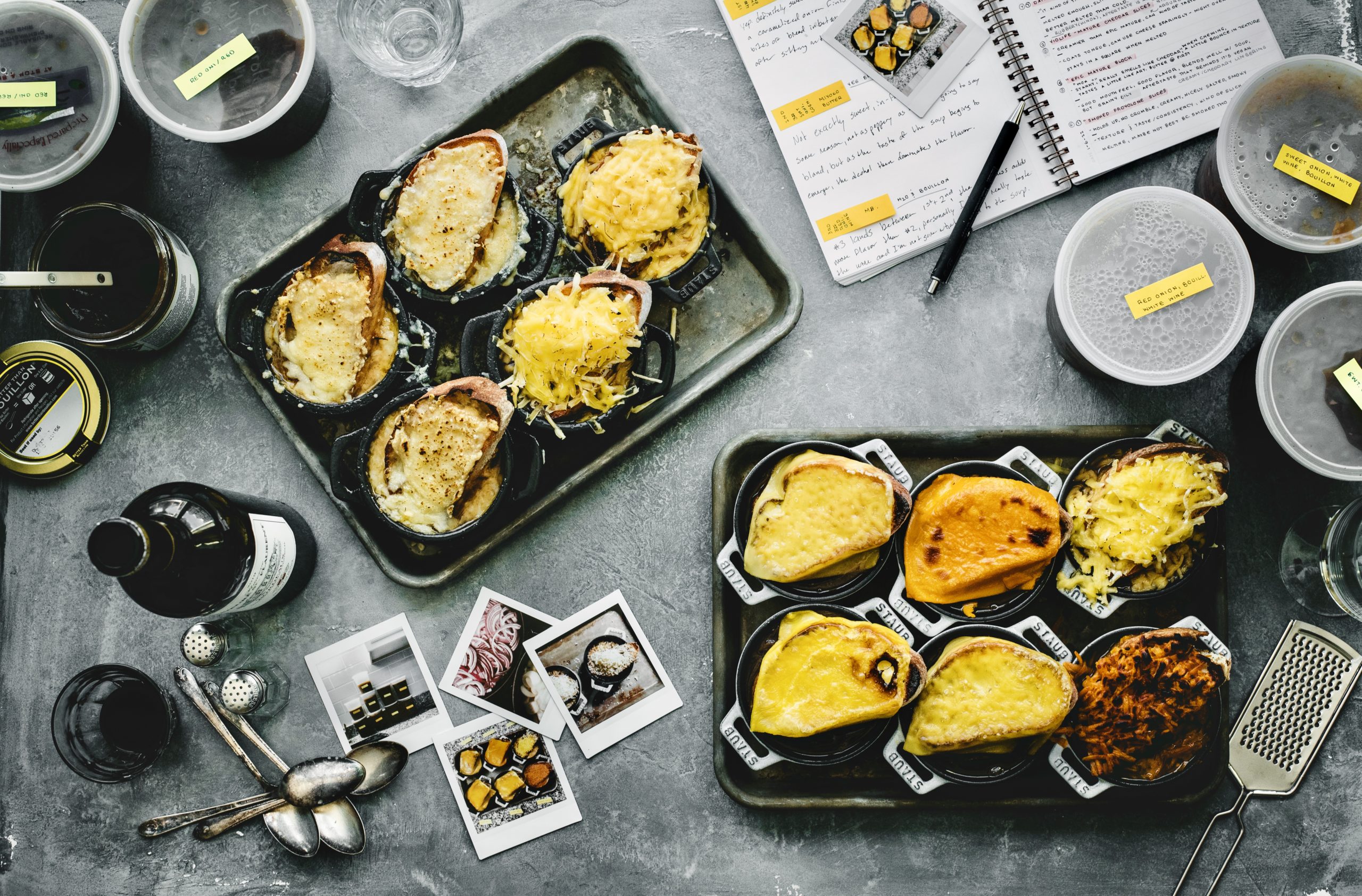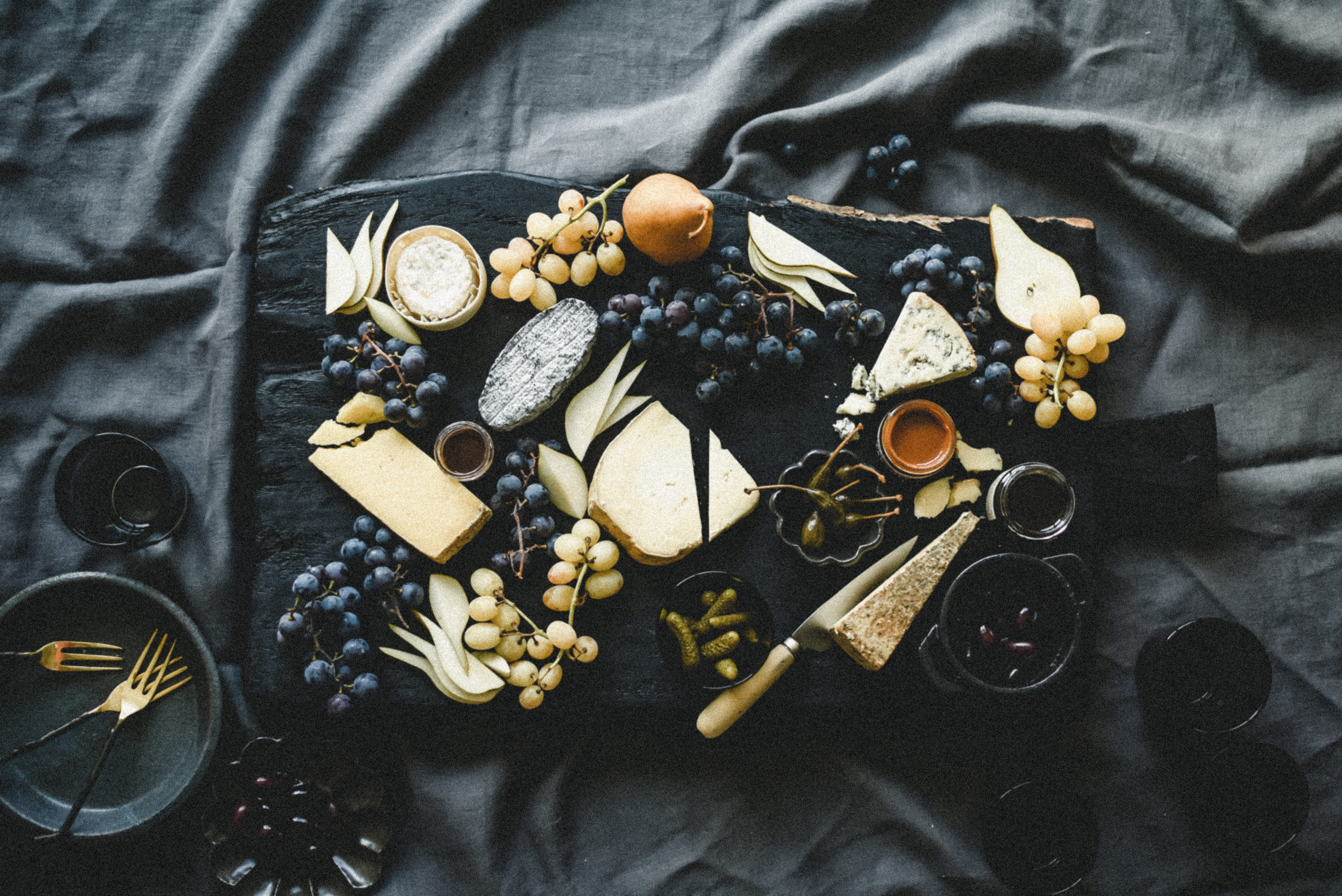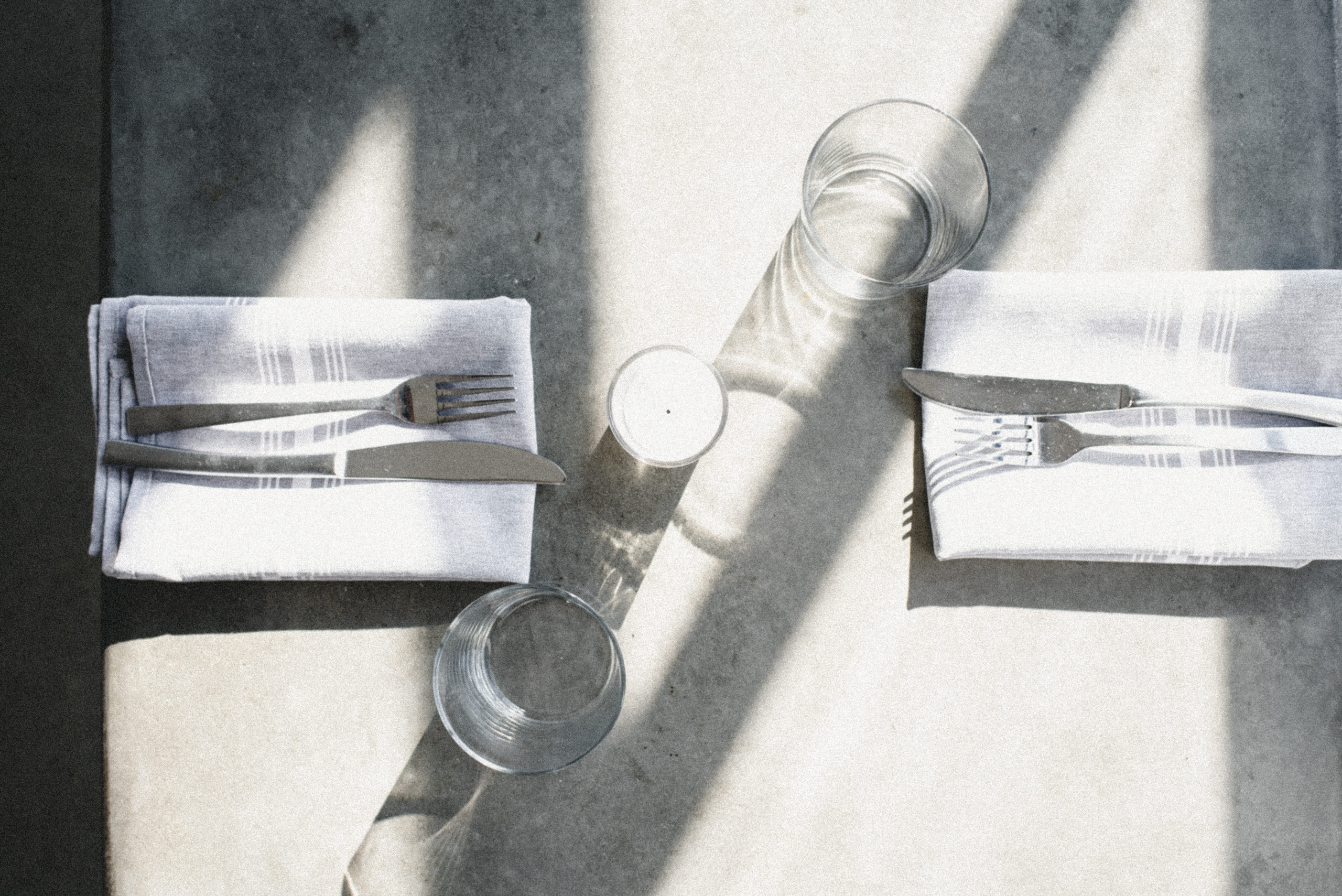Alright, where do I even begin with this onion soup??
***You can scroll to the bottom if you want to skip all this onion soup obsessions talk.***
When an Insta friend (Hi Leslie!) requested a dairy-free onion soup, I was completely on board, particularly because I already had most of the ingredients. Though, what really got me going was when I went down the rabbit hole of variations from the simplest of swaps. From red onions to sweet onions, cognac versus wine, white wine versus red, whether to add flour or not, what types of cheese melts best, and better yet, what kind of non-dairy cheese to substitute with? … (The list goes on.)
However, for just how amazingly straightforward this meal actually is, it is a humble, yet richly savory soup that I just can’t seem to get enough of.
For starters, let me preface that I avoid consuming beef. Therefore, I omit it altogether. Having said that, this recipe is by default, not traditional.
I would also like to add, that these opinions are based off my own personal tastebuds, so by all means, please adjust to your own preferences!
On that note, let’s begin!
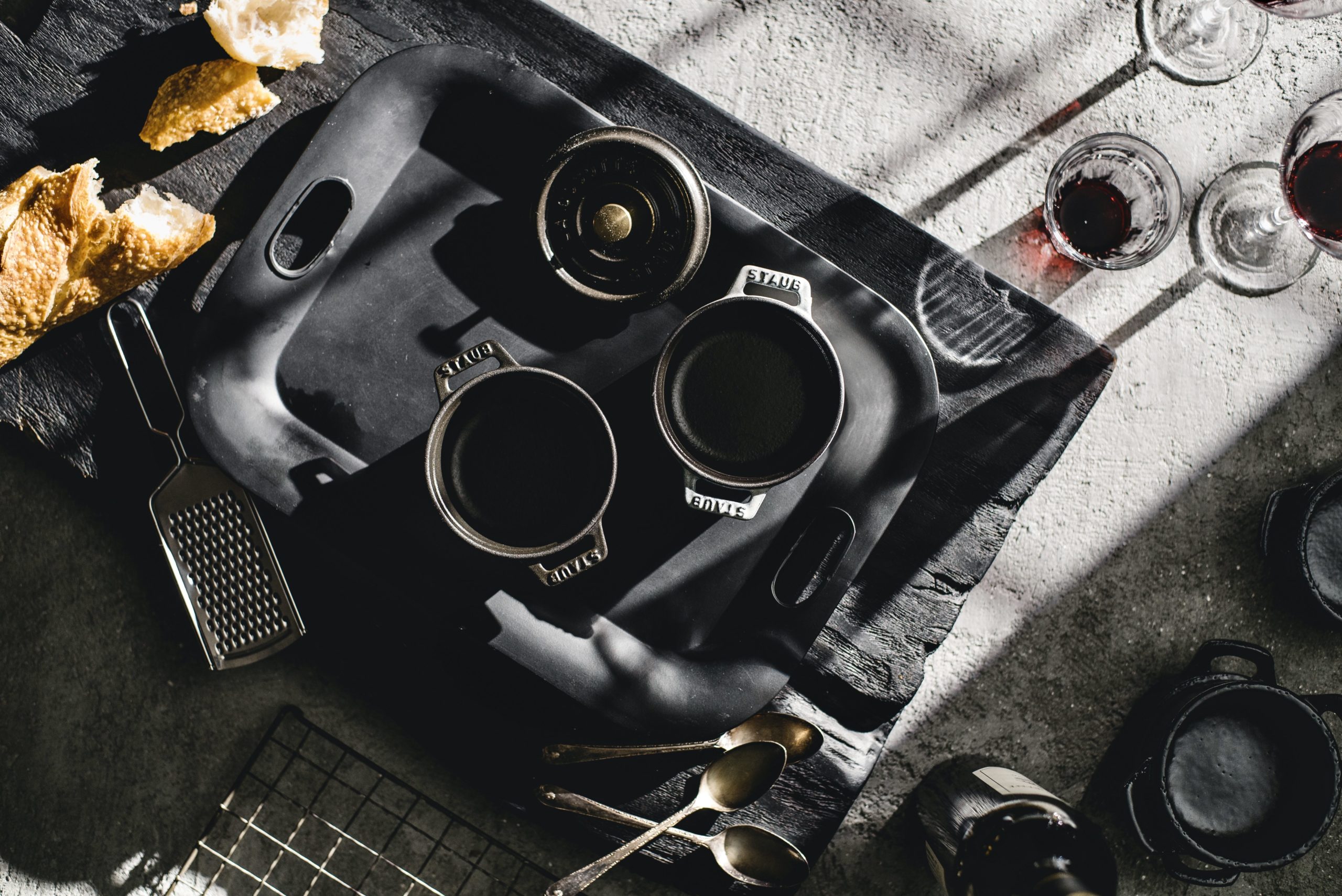
Where did onion soup originate?
“Onion Soup, or in French: soupe l’oignon, has a storied history. References for the soup date back to the Romans. It was originally considered fare for the poor, as onions were plentiful, easy to grow and simple to store. The modern recipe, based on caramelized onions in a rich, beef broth, originates from 18th century France.” – The Ellsworth American
It is said the onion soup consisted of: onions, stale bread, and water. Though nowadays, the modern versions showcase beef stock, caramelized onions, a variety of cheeses, French baguettes, and beyond.
For this version, in place of beef, I opted for more vegetables, a full-bodied Bordeaux, along with some creative alternatives to pack on the umami. However, you can swap with beef bouillon for a classic version. (Though, I highly recommend you give this recipe a try!)
What kind of onion should I use?
Short Answer: Any kind of onion.
Long answer: It depends. If you prefer your soup on the sweeter side, opt for sweet, or Vidalia onions. If you love a more onion-forward taste, go for red. However, if you want something in the middle, try yellow onions or shallots. And if you want a prominent onion flavor but also want sweetness, then go for red and add some sugar (or whatever form of sweetener that best suits your fancy).
If you want to customize your flavor and play with subtleties, mix and match shallots, yellow onions, sweet onions, and red onions. Just have fun and make the most of it!
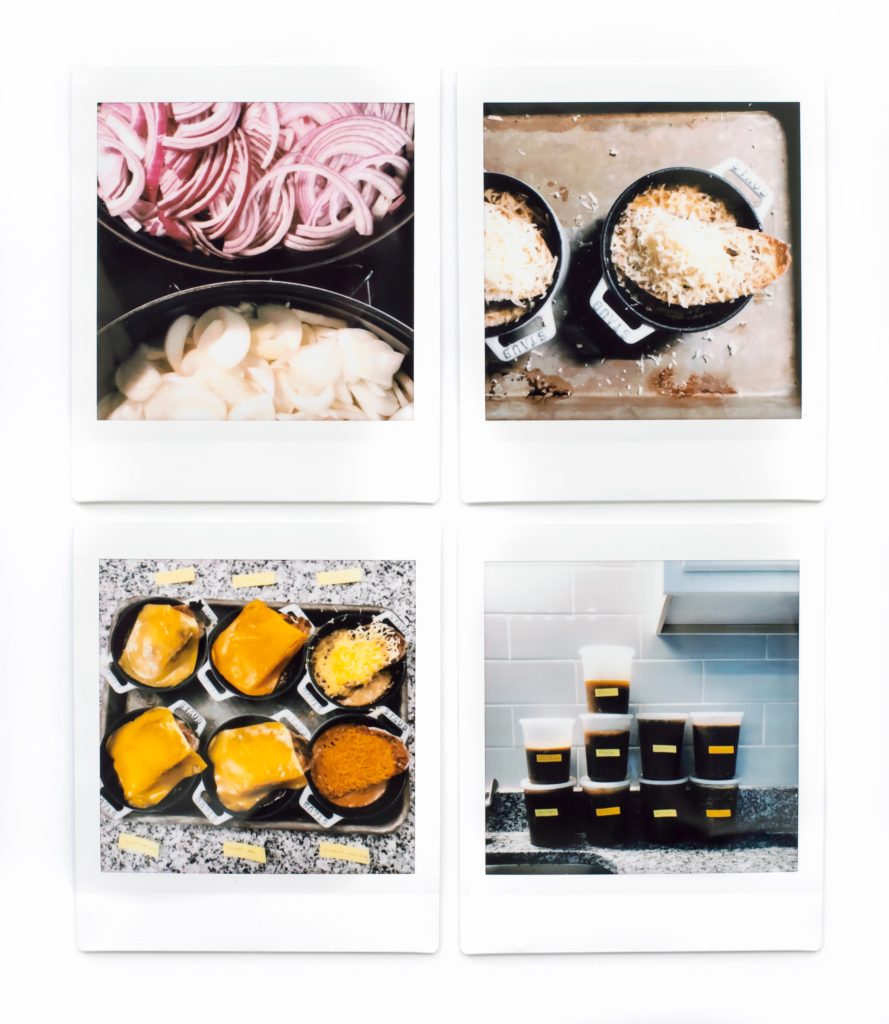
How do onions caramelize?
Let’s take a moment to talk about the chemistry of caramelizing onions.
All living things break down sugars for energy. Plants have the ability to break down sugars from polysaccharides (multiple sugars linked together) to disaccharides (two sugars linked together), or monosaccharides (one singular sugar molecule). When cooking an onion, which has about 9g of sugars, the heat from the pan raises the temperature within the cell walls of the onion. Once the temperature is high enough, it breaks the bonds that link the sugars to together. This reaction is also known as pyrolysis, AKA “the thermal decomposition of materials at elevated temperatures in an inert atmosphere.” (Read more here.)
Long story short: You’re changing the chemical composition of the onion by applying heat, which softens and breaks them down. Because of this, the results are oh-so-sweet. (See what I did there?)
Do I need to add flour to my soup?
Oftentimes, flour is added to thicken soups. However, since I wanted to keep this recipe as straightforward as possible, I just used more onions. The onions breaking down and mixing with the soup thickens the meal without the need for additives. Besides, the bread is there for your flour fix!
Plus, I figured, if someone is considering eating onion soup then they probably don’t mind the serious amount of onions this recipe calls for.
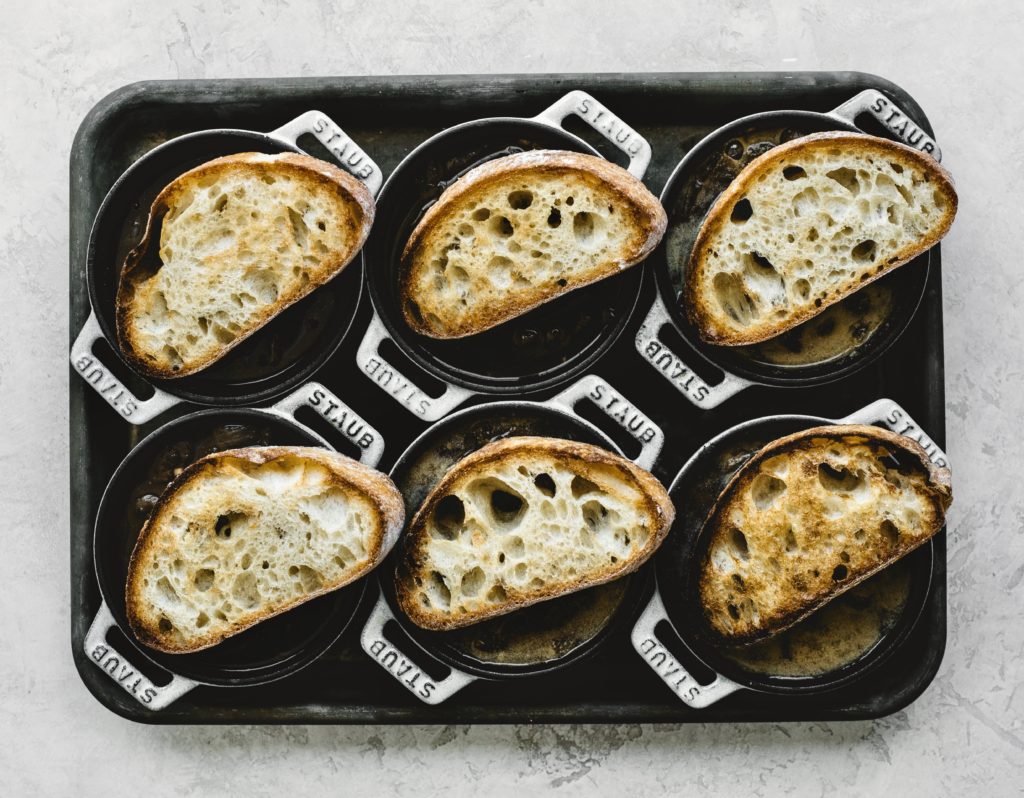
*During the time I developed this recipe I had Chabaso’s Roasted Garlic Ciabatta on hand, and it was AWESOME. Highly recommend if you can’t find a baguette or simply want to try.
What types of cheeses melt best with onion soup?
Great question! Gruyère (which is a type of Swiss cheese) is more traditional, however, mozzarella, gouda, muenster, havarti, cheddar, and just about any younger solid cheese, also makes a great candidate because of its melty goodness! Some people even add grated Parmigiano-Reggiano or other aged cheeses in combination to younger cheeses to add depth of flavor.
Personally, I prefer blocks of cheese as opposed to pre-shredded. Packaged shredded cheeses contain additives to help prevent the cheese shreds from sticking. Therefore, when it comes to baking, pre-shredded cheeses don’t melt as well because of those fillers. The same applies to vegan cheese shreds.
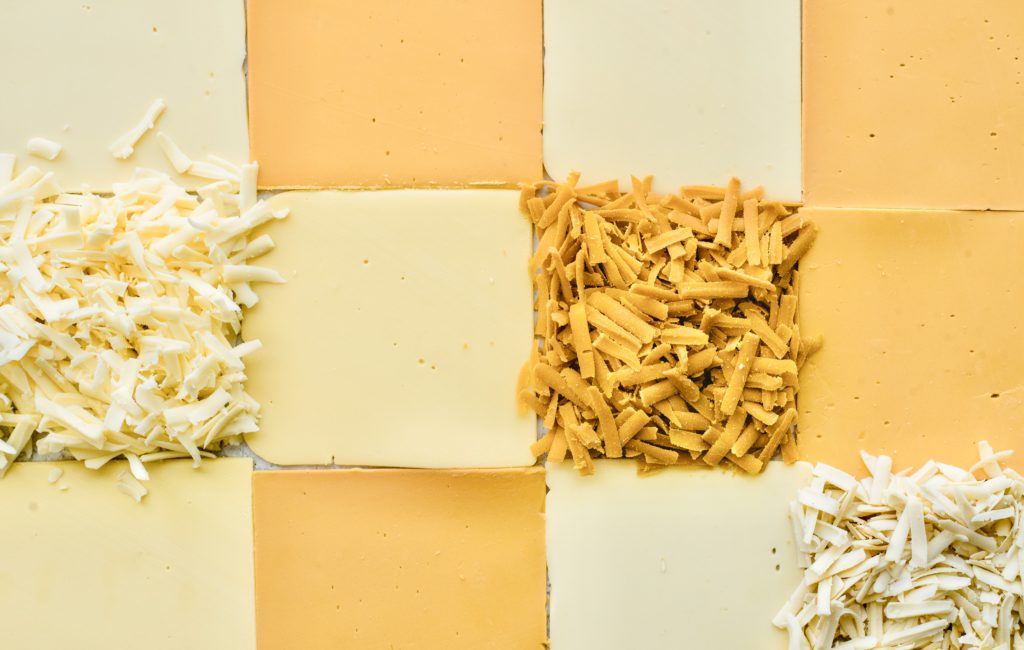
How about dairy-free cheese alternatives?
Perhaps you can’t have dairy, and that’s more than fine! There’s no fear of missing out when there is a plethora of cheese alternatives nowadays. Speaking of, I tried 7 different kinds when developing this recipe. Yes really, 7.
Here is my rating for which ones I thought paired best and why:
- Field Roast Chao Block – It dried out a little when broiled on the toast, however, the pieces on top of the soup had enough moisture to melt nicely. It has a texture that resembles melted cheese the closest. It’s gooey enough, but not in a slimy or goopy way. I preferred this vegan cheese pairing with the onion soup better than its competitors. Unmelted, it somewhat resembles the taste of stringy mozzarella, and is a little bouncy.
- Miyoko’s Creamery Farmhouse Cheddar Block – This really resembles cheddar, though, it has a somewhat chalky consistency and earthy flavor. I think that is because of the beans listed in the ingredients. Looks wise, it burned easier than others. Unmelted, it’s rather dusty and crumbly on the outside. Overall, it has a nice flavor, but cheddar isn’t exactly my first go-to for an onion soup. It would probably make an incredible grilled cheese though (but I’ll test that another time.)
- Field Roast Creamy Original Slices – It definitely smells like cheese. Another said, “Straight up, that’s bussin’.” It’s very melty, and is a decent base line. It’s slightly goopy though.
- Violife Epic Mature Cheddar Flavour Block – Honestly, when unmelted, it’s kind of stinky, but when chewing, it does resemble cheddar. It has a buttery taste in the beginning, and the texture is a bit bouncy. However, when melted, it’s creamy and has a lingering cheddar flavor. Though, it’s a little grainy and has an aftertaste that reminds you it isn’t real cheese. It’s not bad though. I like it.
- Violife Mature Cheddar Flavour Slices – This cheese is creamier than the Epic Mature Cheddar Flavour Block. It has a nice creaminess that wraps around the tongue and lingers. I would use it sparingly since it overpowers the soup. It really stayed in a square when melted.
- Violife Smoked Provolone Flavour Slices – The main reason I didn’t care for this is because the smokiness doesn’t feel quite right with an onion soup. However, it’s great for other things, and was actually a favorite in different categories. It would be much better suited for sandwiches.
- Daiya Cheddar Flavour Slices – Unfortunately, this was my least favorite. One person even said, “It kind of taste like cheddar that went bad.” When melted, it was oddy slippery where the soup was, yet cracked on top of the bread. It was overall too rubbery to get into, and the taste just wasn’t for me. However, it was better melted than cold. All in all, it was alright, but I probably wouldn’t get it again unless I was doing another comparison like this.
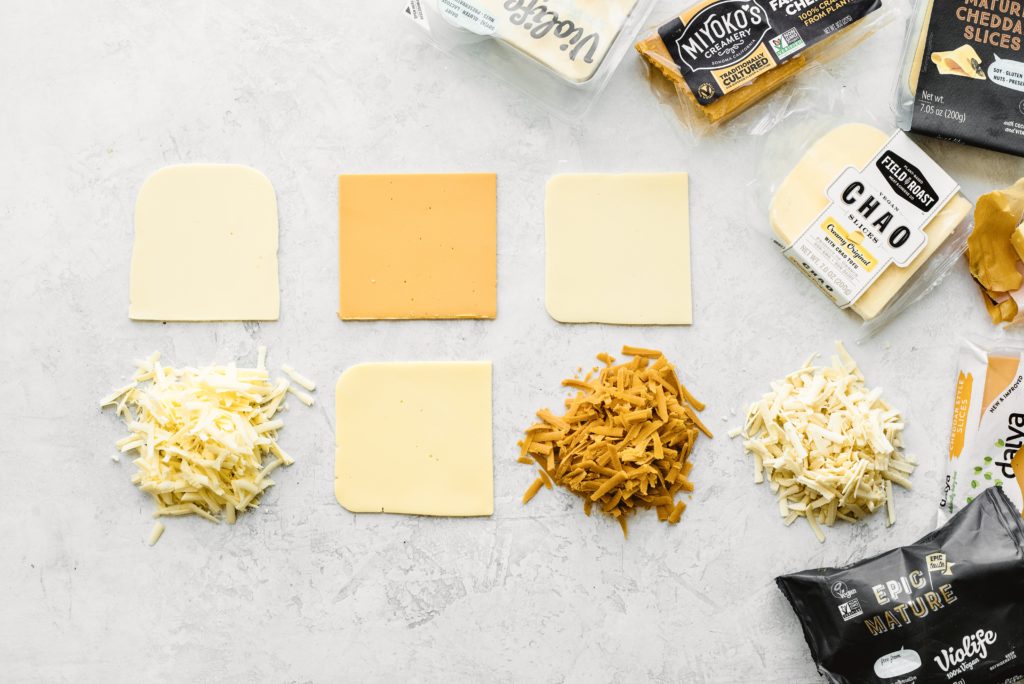
*LEFT TO RIGHT: Field Roast Creamy Original Chao Slice, Daiya Cheddar Flavour Slice, Violife Mature Cheddar Slice, Field Roast Chao Block, Violife Smoked Provolone Slice, Miyoko’s Creamery Farmhouse Cheddar Block, Violife Epic Mature Cheddar Flavour Block

*Unmelted Vegan Cheeses Atop Onion Soup-Filled Ramekins
LEFT TO RIGHT: Field Roast Creamy Original Chao Slice, Daiya Cheddar Flavour Slice, Field Roast Chao Block, Violife Mature Cheddar Slice, Violife Smoked Provolone Slice, Miyoko’s Creamery Farmhouse Cheddar Block
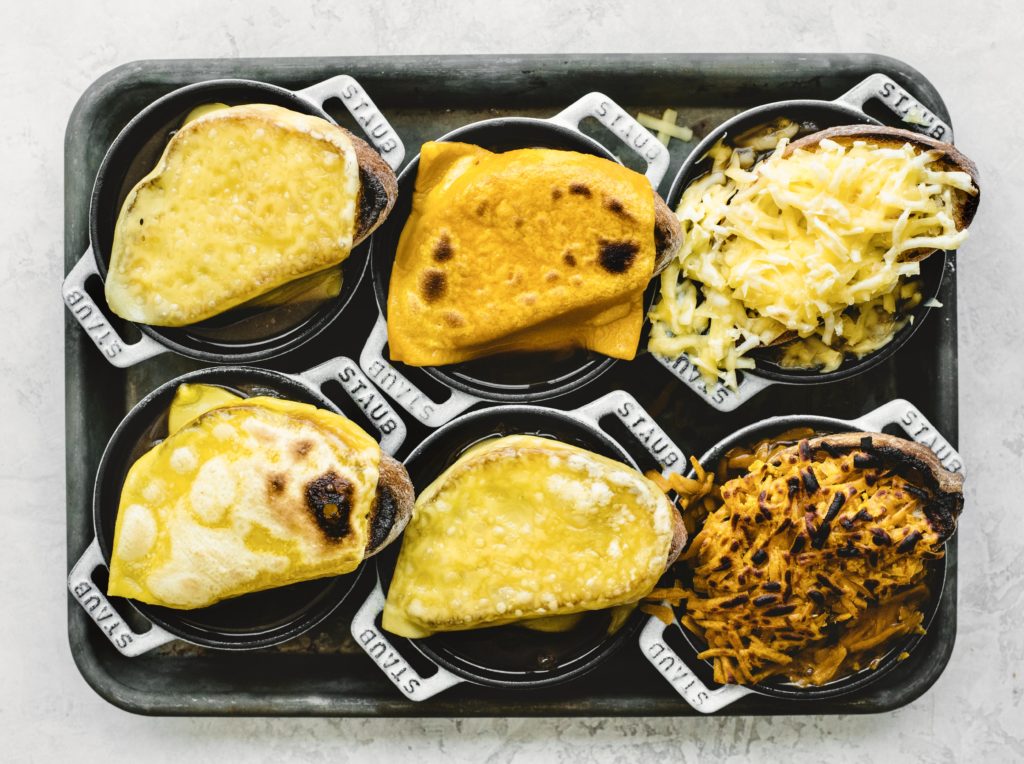
*Melted Vegan Cheeses
LEFT TO RIGHT: Field Roast Creamy Original Chao Slice, Daiya Cheddar Flavour Slice, Field Roast Chao Block, Violife Mature Cheddar Slice, Violife Smoked Provolone Slice, Miyoko’s Creamery Farmhouse Cheddar Block
What kind of alcohol do I use for onion soup?
Traditionally, this recipe typically calls for a dry sherry. In my research I’ve seen cognac, brandy, red wine, and white wine. The purpose of alcohol in this dish is to help deglaze and loosen up any bits stuck to the bottom of the pan, while simultaneously adding more flavor.
Personally, I prefer a dry, full-bodied red wine like a French Bordeaux. White wine was pleasant and equally delicious, but the depth of the red helped compensate for the lack of beef. The cognac was downright too strong and overpowered with a bitter aftertaste.
By the way, some people suggest only cooking with the same fine wine that they would drink. But the way I see it is, if you drink enough wine then everything will taste good. KIDDING! All jokes aside, I prefer using cheaper wines to cook with because the alcohol evaporates anyways. So, save the good stuff to sip and savor with your meal, or while you cook instead!
What are some ways to add depth of flavor if there is no beef?
There are a lot of fun ways to add flavor to this soup. Since there is no beef in this recipe, mixing and matching flavor enhancers is a great way to kick things up a notch in a totally customizable way.
- Fish Sauce: Hear me out. It’s not vegan, however, the umami flavor in fish sauce is due to its glutamate content. “In neuroscience, glutamate refers to the anion of glutamic acid in its role as a neurotransmitter: a chemical that nerve cells use to send signals to other cells. It is by a wide margin the most abundant excitatory neurotransmitter in the vertebrate nervous system.” – Wikipedia (In other words, in this case, it sends signals to your brain that translates to delicious!)
- Balsamic Vinegar: A small amount of an acidic ingredient brightens flavors, especially in rich soups that simmer for a while. Cider vinegar has similar results but is a bit tangier. I personally like to combine both balsamic vinegar and Worcestershire sauce, but you can mix and match to your tastebuds.
- Worcestershire Sauce: Similar to the fish sauce, this sauce adds umami because of the anchovies present. Though, it doesn’t taste like anchovies. Plus, you can opt for vegan versions like: this brand.
- Shiro Miso: Try stirring in 2 Tbs of white/shiro miso towards the end. I have some local miso made by friend Bob Florence of Moromi Shoyu, and it is an unexpectedly delicious way to pack on some flavor!
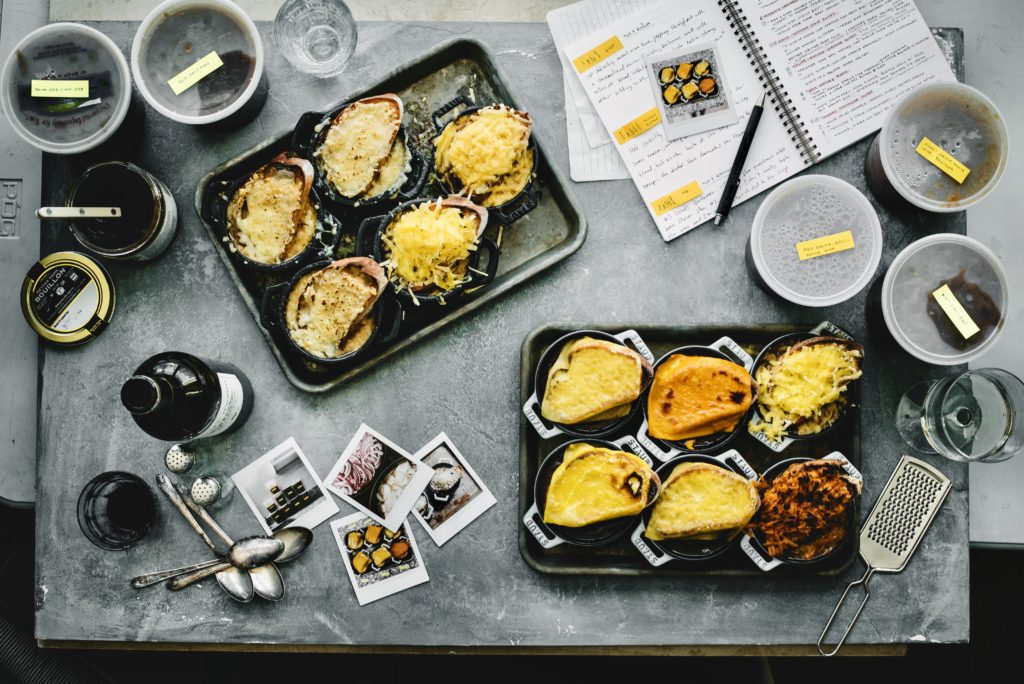
Should I use broth or bouillon mixed with water?
Upon making this recipe a good handful of times, one common factor that set the soups vastly apart from the others was: bouillon.
For some experiments I used standard packaged vegetable broth. For others, I used bouillon mixed with water. The bouillon had more of the “ooh!” factor. Since it’s condensed vegetables with a fair share of sodium, it has a way of making vegetable broth taste like water in comparison. (I’d just be mindful of salt intake.)
Okay, can we get to the recipe now?
If you made it this far, I salute you. Afterall, I told you I went down the rabbit hole haha! Alas, here is the recipe!
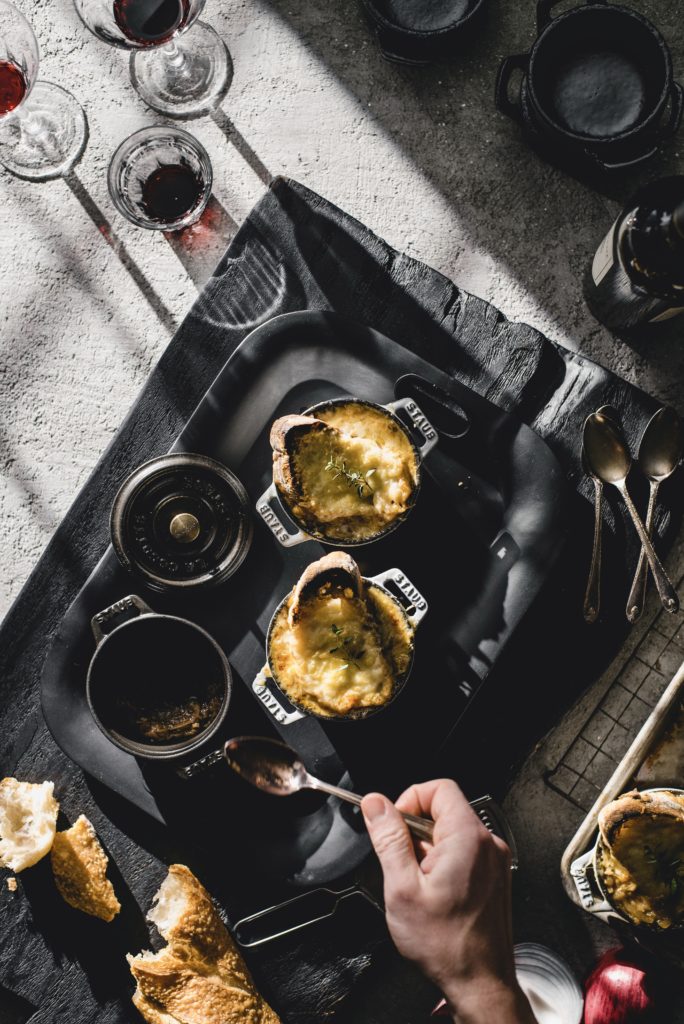
Vegan/Vegetarian Onion Soup
PREP TIME: 15 MIN
COOK TIME: 60-90 MIN
SERVES: 4-6
Ingredients:
- 4 lb. sweet onions, sliced into 1/4” pieces (about 4-5 large onions)
- 1/4 cup butter (light olive oil, or vegan butter works as well!)
- 3 cloves garlic, minced
- 1 tsp+ sea salt
- 1 tsp cracked black pepper
- 2 bay leaves
- 2 sprigs fresh thyme
- 4 cups vegetable stock (I prefer using 2 Tbs Better Than Bouillon Organic Reduced Sodium Seasoned Vegetable Base mixed with 4 cups water)
- 1/2 cup dry red wine (I used a full-bodied French Bordeaux)
- 2 tsp Worcestershire sauce
- 2 tsp balsamic vinegar
- 4 tsp Organic Mushroom Powder (optional)
- Baguette or day old bread (or a gluten free alternative), sliced and toasted
- 12 oz. (2 cups+) Gruyere (or Violife Epic Mature Cheddar Flavour Block for a vegan alternative), shredded
Method:
- Bring a large dutch oven (or large lidded pot) to medium-low heat. Add the cooking oil then layer the slices of onions on top. Season with salt and pepper Allow it to sweat and carefully stir using a wooden spoon, every 5-6 minutes or so. Continue to cook and occasionally stir until the onions caramelize, about 40-60 minutes (depending on stove top and size/type of pot). Look for a super soft consistency, with a rich, golden brown color.
- Afterwards, add the minced garlic. Stir and cook for 2-3 minutes.
- Next, deglaze the pot by pouring in the wine. Scrape at the bottom until it loosens up, then pour in the vegetable stock, Worcestershire sauce, and balsamic vinegar, about 5-10 minutes. Add the bay leaves and thyme, stir, then bring to a boil. After, reduce heat to low, cover, and simmer for 30-45 minutes.
- Meanwhile, preheat the broiler. When the soup is ready, uncover and remove the bay leaves and thyme stems. Season to taste, stir again, then ladle the soup into individual oven-safe crocs or ramekins, then place onto a baking sheet. Afterwards, nestle a piece of toast into each, leaving partially submerged, and layer generously with cheese.
- Transfer the tray into the preheated oven and broil until the cheese bubbles and begins to brown, about 2-4 minutes. Finally, remove from the oven, and serve immediately. (Sometimes I’ll grate some Parmigiano-Reggiano before serving, as well.) Enjoy!
Notes:
- Dutch ovens retain heat better than other types of pots, so keep that in mind for cooking time variations.
- Don’t worry, the onions may seem like an absurd amount, but trust me when I say it reduces down by A LOT!
- If you salt the onions at the beginning of the caramelization process, it will take longer to achieve browning because of the extra water it draws out. Though, the flip side is that your onions will brown more evenly. Though, you can add after caramelization if you want to cut on time.
- For a slow cooker alternative, simply place all ingredients into a slow cooker, except for the veggie broth and wine, then set to high to cook for 8 hours. When ready, boil the veggie broth and wine until it boils, and the alcohol evaporates. Next, remove the bay leaves and thyme sprigs, then stir with the onions. Continue to steps 4 and 5.
- Soup without toast and cheese can be cooled, then refrigerated in an airtight container for up to 3 days, or frozen for upwards of 3 months.
- For an entertaining video of Julia Child and Jacques Pepin making French Onion Soup together, check out this video. When Child exclaims to Pépin, “You have asbestos mouth!” I can’t help but to giggle!
- For other delicious recipes to create or pair alongside, visit the Kitchen Journal. To suggest a recipe, or for any questions, please Get in Touch.
